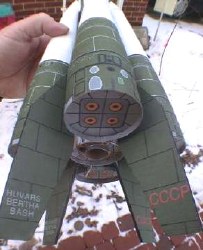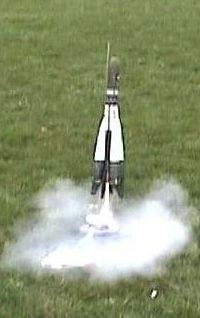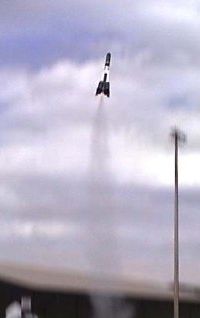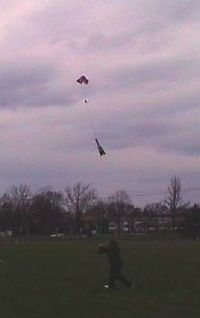| Manufacturer: | Scratch |
The BerthaVostok
Designed and built by Steve Kristal
(Lets just say greater than 25 years of building rockets.)
 Design :
Design :
The design concept for the BerthaVostok originated with an invitation to my local NAR branch's Bertha Bash night, where the goal was to kit-bash something original from a standard Estes Big Bertha kit.
Having seen Gordon Agnello's Gemini Bertha and his brother's Redstone Bertha, I decided to take retro-Bertha even a little further back with a Vostok version.
The design began with a standard Estes Big Bertha, and all the original kit parts were used except the shock cord which I replaced with Kevlar and a shorter launch lug.
The Vostok part of the build was modeled after Peter Always's "Simplified Vostok". (see http://yellowjacketsystems.com/alway/plans.htm#Vostok ).
I upscaled the design to a BT-60 and instead of using Peter's actual templates, I made my own using the graphics from a free paper model by Lars Folman downloaded from the web (see: http://hjem.get2net.dk/).
The body tube graphics were resized from the paper model as well and printed onto full-size label paper which I used as a body wrap.
The hardest part was sizing and making the transition sections. Their length was based on the space "left over" between the lower portion of the upper body wrap and the upper cone of the strap-ons. I significantly compressed the graphics on the upper body wrap to leave enough room for the transition. The overall effect is definitely Vostok-like, but both the upper graphics and the transition are way shorter than either scale or Peter Always's version.
As for stability planning, there was no way I could RockSim this. Instead I simply assumed that adding those big honkin' Bertha fins to an already stable Peter Alway design wouldn't cause any problems. I was right.


As for power, additional weight was negligable with the four strap-ons and transition made from paper. My only concern was all the added drag, but I figured the basic Bertha has plenty of power on a C6.
Construction:
Construction began with the standard Bertha build up to the point of attaching the fins. Upper body wrap was then applied. Next, the upper transition section, with a paper centering ring, was slid up over the bottom of the tube to meet the upper body wrap. The lower body wrap was then applied, and the lower transition section slid up over that to mate with the upper section.
While I anticipated later putting on fins, and left cutouts on the lower body wrap for their placement, I should have also added placement lines for the strap-ons, which I built and placed next. The strap-ons were made from 100# card stock with the graphics printed directly on. Their bottoms were "plugged" with card stock circles with appropriate graphics.
 The fins were covered with label
paper graphics. The fin edges were left flat, and then blackened with permanent
marker. The fins were then placed in the cutouts left on the lower body tube
graphic, and filleted with white glue.
The fins were covered with label
paper graphics. The fin edges were left flat, and then blackened with permanent
marker. The fins were then placed in the cutouts left on the lower body tube
graphic, and filleted with white glue.
Because of the width of the transition, the launch lug was applied to a cut out on one of the fins.
The only painting was the nosecone, which was Soviet-era olive drab.
Overall, the build was fun, but if I did it again I would place the fins first, and then the strap-ons. Both would be a lot straighter if I had done it that way. But, on the other hand, the flights wouldn't be nearly as interesting.
Flight & Recovery:
Flight of this rocket is surprisingly straight, considering the lack of positioning aids for both the fins and strap-ons. It flies kind of like a cross between a Bertha and a saucer as it tail wags it's way up. Really fun to watch and recovers easily on the standard Bertha chute.
Hits about 400' on a C6 but did an end-over-end flip on a B6 (possibly a bad engine, and really cool to watch, but I won't try that again).



Conclusion:
Overall, one of the stupidest rockets ever built. A marriage of the genius of Sergei Korolev and Vern Estes. Really, really fun to build and fly, and lots of laughs from those who know and love rockets.
 |
 |